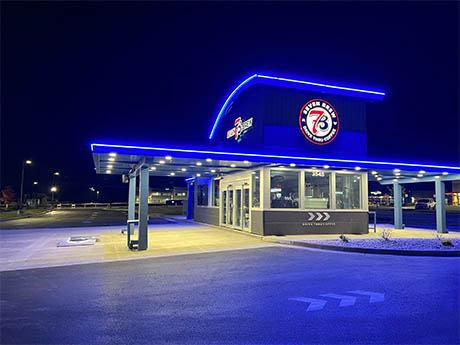As the nation’s 28th-largest city, Louisville is home to a dynamic, diversified economy. The Greater Louisville region draws workers from a 26-county area in Kentucky and southern Indiana, providing an ample and reliable source of educated and skilled employees. The geography of Louisville, specifically its accessibility to the Ohio River, central location nationally and mild climate, have contributed to its ability to grow and evolve.

Additionally, reducing the income tax rate in Kentucky is a goal of the current Republican majority State Representatives to further economic development, and the Democratic governor (Gov. Andy Beshear) is also supporting this reduction as a way to help ease the burden of inflation for residents.
Legislation passed in 2022 dropped the individual tax rate from 5 percent to 4.5 percent for tax year 2023, and a bill signed earlier this year by Gov. Beshear drops it again for 2024 to 4 percent. The goal is to ultimately get income tax rates down to zero, or very close to zero, in 50-basis-point steps as certain budget metrics are hit. These measures seem to be working for growth in the Commonwealth.
One of the more notable capital investment projects is the Ford partnership BlueOval SK Battery Park going south near Elizabethtown. The project is estimated to employ over 5,000 people and add $800 million to the Elizabethtown area once complete.
Following this trend are major retail projects such as Cedar Creek Crossings. The retail center, developed by Hogan Real Estate, is located on a little more than five acres near Bardstown and Cedar Creek roads. Hogan continues to produce high-quality projects such as Cedar Creek Crossings throughout the Louisville metro area.

The success in development and leasing of this project shows the desire of retailers to enter the market, and the related success of retailers since its opening — including Chipotle Mexican Grill, McDonald’s, Starbucks Coffee, Crumbl Cookies and First Watch — shows the demand of consumers in this market for additional goods and services.
This $20 million project is firmly in the heart of Fern Creek, a new growth hotspot where retailers are reporting high sales volumes. Growth includes new-to-market grocer Hyvee with the purchase of 12 acres in Southpointe Commons. Additional retailers coming to the trade area include Bubba’s 33 and 7 Brew Coffee.

Medical facilities and residential development are also increasing in the Fern Creek area. Baptist Health is planning a new freestanding emergency department and urgent care facility. In total, the development is expected to span 11,000 square feet across 1.4 acres.
Multifamily growth in the area continues as well with Cedar Creek Flats, which is currently under construction by Highgates Group and Joseph Waldman. This will be a 192-unit complex. Additionally, Hagan Properties is planning a 324-unit complex on 19 acres along Cedar Creek Road.
Another project that continues to evolve, though not new, is McMahan Group’s Old Brownsboro Crossing. The impact has been great on the community and satisfies the need for a mixed-use commercial center. The developer created a new medical district within the city limits, and also attracted anchors like Costco, Bass Pro Shops and Lowe’s Home Improvement.
We have seen demand for existing real estate product for redevelopment skyrocket to an all-time high in the Louisville retail market. Due to the ever-increasing cost of construction, it’s more feasible to alter sales floors, kitchens and store layouts in conversion opportunities as opposed to growth through new construction.
However, inflation has impacted labor and materials greatly. This increase in construction costs and the cost of doing business for retailers is impacting their prices of goods and services sold to consumers. For restaurants, that may mean reduced portions or cutting menu offerings that generate the lowest margins.
Conversely, our relatively low cost of rent has insulated Louisville from many rounds of closures as seen in other larger cities. As an example, Party City has retained three stores within the Louisville market. Louisville landlords were able to find deal structures that allowed Party City to continue to operate within the market.
Those of us based in Louisville have witnessed its impressive and continued growth over the last 10 to 15 years. Perhaps the continuing trend of population movement from high cost of living areas to lower cost of living areas, as well as the decrease in tax rates, will fuel even faster growth in the market in the coming years.
— By Morgan Merrill, First Vice President, National Net Lease Group; Sarah Shanks, First Vice President, National Net Lease Group; and Casey Smallwood, Senior Vice President and Managing Principal of SRS Real Estate Partners. This article was originally published in the September 2023 issue of Southeast Real Estate Business.


